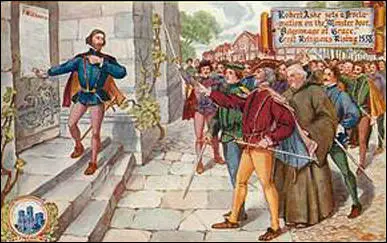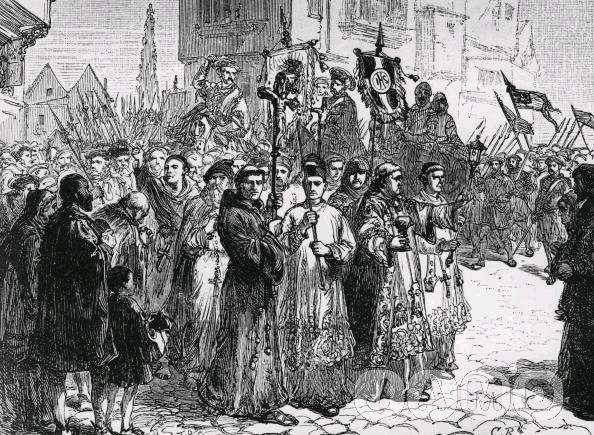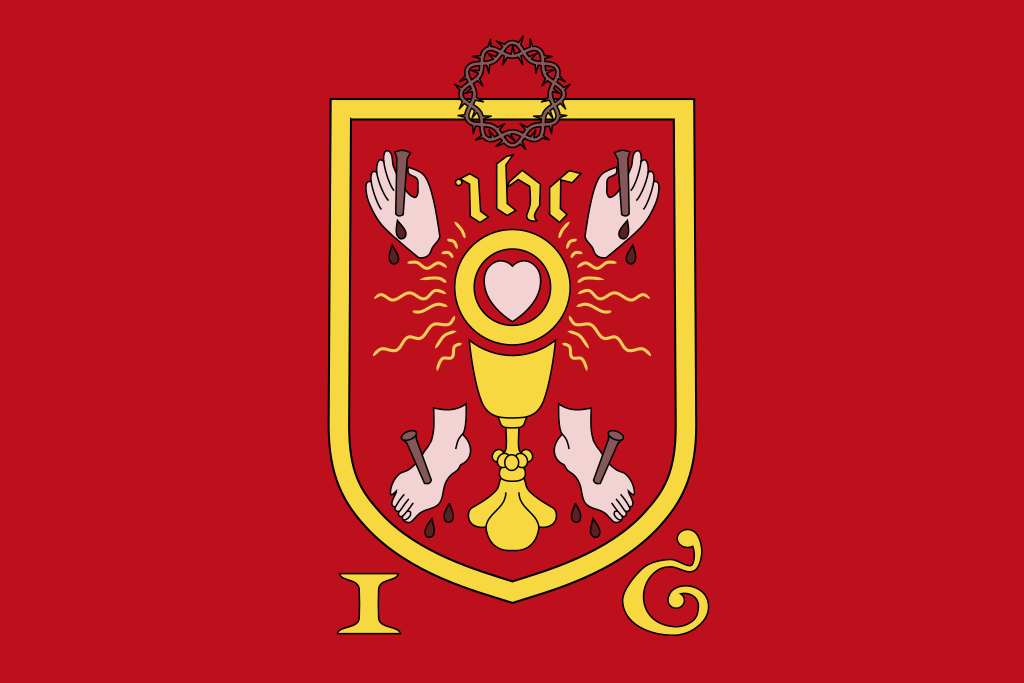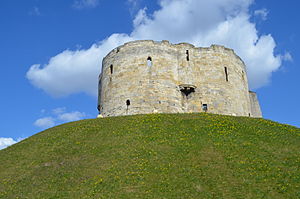
The
Pilgrimage of Grace was a large popular uprising in Northern England which rose
in response to the religious and economic policies of Henry VIII.[1] The
dissolution of the monasteries led to the worst uprising during the reign of
Henry. The rebellion began at Louth in Lincolnshire in early October 1536. While the Lincolnshire
rebellion lasted only a fortnight the rebellion spread to Yorkshire. With an
army of over 30,000 the pilgrimage posed a serious threat to a kingdom lacking
a standing army. Many accept that
religious differences were a chief cause
of the Pilgrimage. The position of Roman Catholicism in North England remained
robust, while Protestantism found an unsympathetic audience. The seizure of the
monasteries by royal order stirred many of the commoners to action as
monasteries endured as centers of devotion. Pilgrim’s anger over the closings
led to rage toward authorities associated with the dissolution of the worship
centers which they so richly treasured.[2]
The most divisive religious issue was the Royal supremacy which declared Henry the
head of the English church. While many Northerners forcefully rejected the Act
of Supremacy, others reluctantly and narrowingly accepted the Act. The variety
of motives regarding the royal supremacy within the rebels reveals itself by
the absence of the Act in many of the lists and platforms early in the
Pilgrimage.[3]
 |
| Portrait of Henry VIII by Han Holbein from Wikipedia |
But religion was not the
only motive for the rebels. While religious symbols and slogans shined brightly
during the Pilgrimage, economics was also
a prime motive for the rebellion. Chief among the economic concerns was the
practice of heavy taxation especially, during peacetime. Many believed that the
practice of oppressive taxation during peace was not only burdensome but
unconstitutional as well. Taxation was expected for the defense of the nation
but was highly detestable when there was no danger from war or invasion. The
unpopularity of taxes granted in 1534 which made no allowance for poverty spread
through all social classes. The 1536 Statute of Uses closed the loophole which
both nobility and gentry evaded feudal payments.[4]
Complaints about the Statute of Uses was
one of the first grievances set forth from
the Lincolnshire gentry.[5]
These same concerns attracted lawyers such as Robert Aske, who was instrumental
in the Pilgrimage leadership. Aske is a good example of a pilgrim holding both
religious and financial motives for his protest. He demonstrates his religious
devotion in his composition, The Oath of the Honourable Men saying, “Ye shall
not enter into this our Pilgrimage of Grace for the commonwealth, but only for
the love that ye do bear unto almighty God, his faith, and to holy church
militant.”[6]
But Aske also reveals his economic concerns in his account of his meeting with
nobles and gentry at Pontefract,
And that now the
profites of abbeys suppressed, tenths and
furst frutes,
went out of those partes. By occasion wherof, within short space or [of] yeres, there should be no money nor tresor in thos
partes, nether
the tenant to have to pay his rentes to the lord, nor the lord to have money to
do the King service with all.[7]
Aske
believed that once funds were exhausted from the dissolution of the abbeys and
monasteries that the property of the nobles and gentry would be the next
target. Also the North faced the prospect
of a failed harvest in 1535 which impacted both gentry and commoners. In
combination with taxes, the North faced burdensome economic conditions.
 |
| Robert Aske in Yorke from Spartacus Educational |
The Subsidy Act of 1534 was
groundbreaking since it justified taxation in peacetime because of the “civil
benefits conferred on the realm by the king’s government.”[8]
The justification for taxation takes a new direction with the subsidy as taxes exist
not just for the common defense but also for the privilege of residing in the
kingdom.
The clergy also faced onerous
taxation. Many viewed clerical taxation as part of Henry’s assaults on the
church. The Valor Ecclesiasticus
taxed the clergy for ten percent of the “value of clerical benefices.”[9] On
the reverse, many also complained about forced tithes. Some such as the
Cumberland protesters believed that tithes should be voluntary. This proposal
brought conflict between laymen and
priests, with many priests viewing the idea
as another attack on the church. Further disagreement arose over the economic
policies of the Pope. Even within the Pilgrimage, there were those who
expressed resentment toward Rome because of the ecclesiastical
seizure of resources. These rebels did not envision a return to an arrangement
that allowed the Catholic Church with the ability to receive riches from the
English sees.[10]
In addition to real taxes and
levies, the rumor of taxes became just as convincing for many Northern rebels. Taxes
on livestock, acreage, and even on ecclesiastical church functions such as
baptisms, marriages, and burials became widespread gossip. One rumor even
claimed that a tax would yield a third of all a man owned. These rumors often
alarmed the poor with claims that peasants faced stiff taxation.[11]
Even the religious motivations of
the pilgrims contained a mixture of economic concerns. Many objected to the
closure of the monasteries and abbeys for purely spiritual motives, but others
saw the religious centers as economic centers of employment for peasants but
also as centers of charity. The monasteries cared for the poor during times of
need and want, while the king offered no charitable alternative. When defending
the monasteries Robert Aske not only provided spiritual reasons for their
maintenance, but included reasons such as alms-giving, hospitality, and
education.[12]
The monasteries were an economic engine for many people and provided many
functions for society. The rebels not only saw a religious vacuum with the
absence of the monasteries but the disappearance of economic opportunity.
 |
| Pilgrimage of Grace from Wikipedia |
The settlement at Doncaster also reveals the
economic concerns of the rebels. Many assumed that there would be a halt on the
payment of disputed taxes until a parliament would meet in York. Many
questioned Aske on the reliability of the supposed moratorium since the clerical
subsidy or “tenths be gathered.”[13]
Aske avoided the question, but the results were clear. The King still intended
to collect all taxes.
But for many pilgrims their concern
was philosophical. They asserted that Henry’s kingdom did not function as a Christian
commonwealth. Many blamed Henry’s ministers especially
Cromwell, while some laid the blame at the feet of the King. But they arrived
at these conclusions because they believed that a Christian kingdom dealt justly
with their subjects and that all citizens along with the king cooperated for
the mutual benefit of the realm. Unjust punishment and burdensome taxes did not
mirror the principles of a devout Christian kingdom. A Christian society was a rightly ordered society, and the Henrican
realm appeared broken in the eyes of many
pilgrims.[14]
 |
Banner of the Holy Wounds, used during the Pilgrimage of Grace. An English counter-revolution in 1536 against schism from the Catholic Church and against the destruction of the monasteries from Wikipedia |
Facing a fatal danger to his rule,
Henry utilized diplomacy and negotiation through the Duke of Norfolk. The
rebels’ only motive was to see the return of monastic lands and a discussion of
their concerns within Parliament. The combination of seizure of the monasteries
with the practice of high taxation caused many in the north to place most of
the blame upon the King’s ministers especially Thomas Cromwell. The vast
majority of those involved in the pilgrimage refused to place blame upon Henry.
The King granted conceded to all of the
rebels demands and the uprising dispersed but soon afterward Henry soon broke
his word and declared martial law. Rebel leaders faced trial and up to 200
including Aske were executed.
 |
| Clifford's Tower, the scene of Aske's execution in 1537 from Wikipedia |
The Pilgrimage of Grace was one of
the largest popular uprisings in English history. The rebels possessed a force
large enough to capture London if they desired. But their failure points to the
contradictions within the pilgrims. There was never a clear agreement on the
goals and purposes of the Pilgrimage. The inability for the rebels to
demonstrate their goals reveals that even “the traditionalist Catholic
population was severely divided.[15]
Bibliography
Fletcher,
Anthony, and Diarmaid MacCulloch. Tudor
Rebellions. Harlow, England: Pearson Longman, 1968.
MacCulloch,
Diarmaid. Thomas Cromwell: A
Revolutionary Life. New York: Viking, 2018.
Shagan, Ethan H.
Popular Politics and the English
Reformation. Cambridge: Cambridge University Press, 2003
[1] Ethan H. Shagan, Popular Politics and the English
Reformation (Cambridge: Cambridge University Press, 2003),
89.
[2] Shagan, 99.
[3] Shagan. 101-102.
[4] Shagan, 106.
[5] Anthony Fletcher and Diarmaid
MacCulloch, Tudor Rebellions (Harlow,
England: Pearson Longman, 1968), 48.
[6] Fletcher and MacCulloch, 143.
[8] Fletcher and MacCulloch,39.
[9] Shagan, 106.
[10] Shagan, 103.
[12] Shagan, 100.
[13] Shagan, 116.
[14] Shagan, 91.
No comments:
Post a Comment